Contact Us
Send Us a Message
Need expertise and innovation on your project? Our team can help.
Let’s jump right into it: if a website crashes regularly, it’s time to find a solution.
As we’ve talked about before, even 100ms of lost site speed can cost revenue. That figure balloons if your website is not working properly or consistently.
In this article, we will discuss the top three reasons why websites go down and what you (or your agency partner) can do about each one.
Reason No. 1: Traffic Issues
Large amounts of web traffic can overwhelm websites that are not equipped for it. If your website crashes due to high traffic, here are some suggestions to troubleshoot the issue.
High Traffic Volume
The Problem
This is a straightforward issue: your website can’t handle the number of visitors coming its way. Your traffic source might be real users or bots, but either way, if the traffic volume exceeds capacity, your website will crash or run slow.
How to Solve It
This straightforward issue also has a straightforward solution: upgrading your server to increase capacity to handle site traffic. You can upgrade your server by:
- Increasing the disk space
- Moving from a shared server to a dedicated server
- Migrating to a higher quality environment (we use WPEngine)
Your technical partner will be able to assist you with finding the right configuration based on average and peak traffic times to your site.
These fixes assume that the traffic to your site is legitimate or benign. For some traffic issues, the root cause lies with a security issue (see DDoS below).
Read More: How Quality Hosting Can Improve Core Web Vitals
Database Overloads
The Problem
In order to run properly, your website’s codebase will fetch information from a database. If the database has issues handling the amount of requests, this will cause similar issues to a traffic spike, even if the server has been upgraded.
How to Solve It
There are two common solutions to this problem. The least invasive and most common is to install a caching plugin like WP Rocket. This makes it easier for your website to retrieve information and reduces the load on the database.
If caching doesn’t solve the problem, the next step is to rework either the codebase or the database. Your developer will first look at the code and find ways to “refactor” the queries to the database so they’re easier to retrieve.
Reason No. 2: Technical Problems
Technical errors comprise a broad range of website issues. Developers will identify and fix specific technical issues with your site, but we have outlined common categories of technical issues you may need to fix if your website keeps crashing.
Code Errors
The Problem
Code errors come in all sorts of shapes and sizes. At a high level, there are two types of coding errors that can cause your site to fail:
- Server-side coding errors disrupt your hosting environment. The faulty code could be in the server’s operating system, the script library your website needs to work properly, or the website codebase itself.
- Client-side coding errors cause disruptions on your users’ devices. Your website’s scripts can cause the browser to fail, or cause pages of a webpage to crash.

How to Solve It
Running a website audit is the first step to finding and identifying code issues. A typical website audit will include:
- Checks for common server-side coding errors.
- An audit of third-party plugins and libraries.
- A core web vitals assessment.
- For more in-depth audits, manually audit the code and write comments for further work.
Each website is unique, so the specific fixes will range from running simple software updates to refactoring parts of the custom code.
Get Help Now: Fix My WordPress Website
Software Updates
The Problem
An update of the core software, website theme, or plugins causes compatibility issues, breaking parts of the website.
How to Solve It
Rather than updating directly on the live site, support agencies will create a “staging” site to preview the changes prior to publishing on your website. For live sites that break, the agency will revert to a backup of your site and fix the issues before publishing again.
Inadequate Testing
The Problem
Similar to software updates, a website can crash on a specific network, browser, or device because an agency’s Quality Assurance process didn’t adequately address (or worse, ignored) bugs for specific users.
How to Solve It
Business owners need to have an honest, transparent conversation about what goes into their agency’s QA process.
If the agency is unable or unwilling to make adjustments to better serve its site users, you may need to switch providers.
Read more: How to Manage Website Disruption
Issues With Third-Party Services
The Problem
A library, plugin, or other third-party service has its own outage that disrupts your website. As an example, in October 2023 an update to Cloudflare caused a complete disruption to all its services.
If your site used Cloudflare in any capacity, this would have prevented your site from working properly.
How to Solve It
For one-time issues, your agency partner will put in a ticket with the third-party provider (if they offer support) and work with the provider to resolve the issue.
In some cases, your developer may have to replace the third-party service with another or build a custom solution to prevent the disruption.
Reason No. 3: Security Issues
This is the worst-case scenario. Your website is either open to exposure or worse, it has actually been exposed to nefarious actors.
Security Certificate Issues
The Problem
All websites are required to have a Secure Sockets Layer (SSL) certificate to function properly on modern browsers.
Without it, users will get a warning that your site is not secure, and third parties can intercept connections to your site in transit, causing disruptions.
How to Solve It
Out of all the security issues we highlight here, this is the simplest to solve. Keeping your SSL certificate up to date and properly implemented is easy for a hosting and maintenance provider.
DDoS Attack
The Problem
Distributed Denial of Service (DDoS) attacks hack vulnerable devices and use them as bots to flood your website with fake traffic. The traffic appears to be legitimate, but the volume overwhelms the site, causing it to crash.
How to Solve It
Your hosting and maintenance provider will need to build a specific plan to prevent DDoS, especially if your site gets large amounts of legitimate traffic.
The plan will include monitoring for unusual spikes, adding firewalls, and choosing a cloud hosting environment resilient to DDoS.
SQL Injection
The Problem
A hacker uses a webform or another means of accessing your website and adds a series of database queries to attack your website.
How to Solve It
Secure your web forms with different types of “validation”:
- Encrypt password fields
- Limit the number of characters in text fields
- Reject form submissions with improper information submitted (i.e., all phone number fields have 10 digits)
- Store form information in a secure database
Cross Site Scripting (XSS)
The Problem
An attacker intercepts traffic from a user and injects code into your website through the user’s actions, such as clicking a link or submitting a form.
How to Solve It
There are several steps to preventing an XSS attack, including protecting form submissions as you would to prevent SQL injections. Another technique is to add a content security policy to your HTTP headers to prevent this type of attack.
Conclusion
Websites are vulnerable to breaking from all sorts of different sources, but that does not mean you need to worry. Working with an agency with the technical expertise to prevent website crashes will give you the peace of mind you deserve.
Learn more about TechArk’s website maintenance services, and see how we can help keep your site up and running 24/7.



